6 community-led advocacy tactics that turn members into advocates
Your best customers would happily tell others about you—if only they knew how, when, and where to do it effectively. Without that framework, you're leaving advocacy (and growth) to chance.
Meanwhile, 75% of B2B buyers are actively seeking peer recommendations before they buy, and 96% of consumers read reviews when considering local businesses. They're ready to listen. Your advocates are ready to share. The only thing missing? A system that connects them.
This guide shows you how to build that system inside your community. You'll learn:
- Why communities are the ultimate advocacy engine
- How to turn customers into genuine advocates
- Metrics to measure the success of your advocacy campaigns
What is advocacy marketing?
Advocacy marketing (basically) means getting your best customers to do your marketing for you. By leveraging their personal networks and genuine enthusiasm, you tap into the most powerful growth engine there is: trusted word-of-mouth recommendations from real people.
It's incredibly cost-effective because it's powered by two things: your members genuinely loving what you do, and their friends not wanting to miss out on something good. (Though it can also be used for paid programs!)
Customer advocacy usually happens through three main ways:
- People talking about you (to others as ambassadors, or to the world as reviews and testimonials),
- Referring friends directly (via referral, affiliate, or partner programs), and
- Sharing content about their experience with your brand (UGC).
These authentic recommendations from trusted peers build trust faster than any ad campaign and turn into real sales—at a fraction of the cost.
What’s the difference between loyalty, referral, and advocacy
You'll see these terms used interchangeably, but there are subtle differences in how each approach works:
💙 Loyalty campaigns focus on keeping existing customers happy and coming back through rewards programs, VIP perks, and exclusive access.
🗣️ Referral campaigns are transactional—you give someone a specific incentive to bring in new customers through referral codes, cash rewards, or discounts.
📢 Advocacy campaigns create genuine fans who promote you without being asked or paid, through community building, amazing experiences, and empowerment.
But here's the thing: Most successful programs blend all three. A loyal customer (keeps buying) is more likely to advocate (speak positively) and refer (bring friends).
The bigger point? Community-driven advocacy beats traditional programs every time because it turns customers into genuine fans, not just people chasing rewards. So let’s figure out how to build exactly that.
Why communities are the ultimate advocacy engine
Think about it: when was the last time you bought something because a friend raved about it? Now compare that to how you feel about obvious affiliate links and "Hey, use my code for 10% off!" messages.
Advocacy grows where authentic relationships (and trust) live. And nowhere do relationships flourish quite like communities—where people actually want to help each other succeed, share real experiences, and celebrate wins together.
Here's what we've learned from working with hundreds of community builders: communities are advocacy amplifiers. Every engaged member becomes a potential champion, and every genuine connection creates exponential reach.
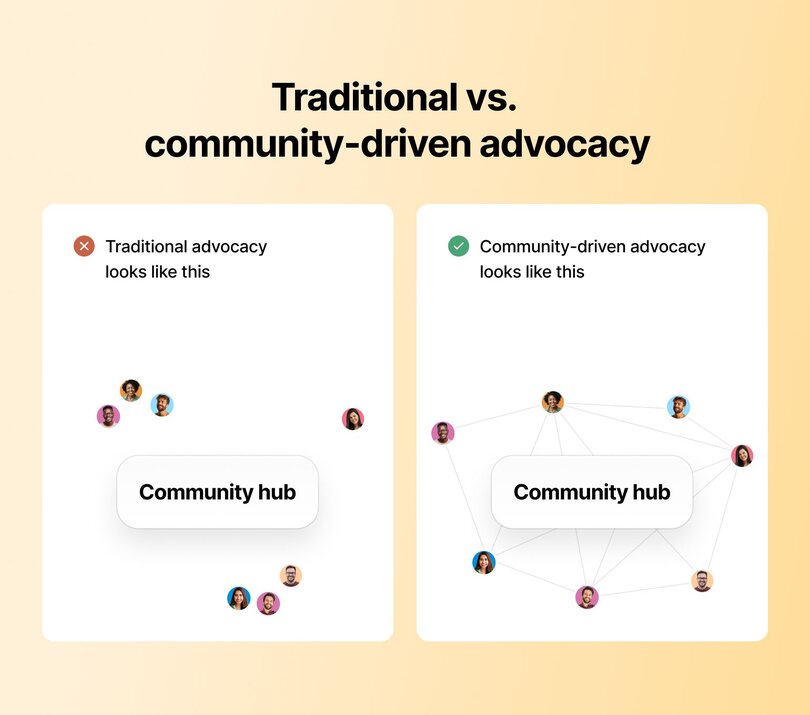
Traditional advocacy looks like this:
One person tells a few friends. Those friends might tell their friends. Maybe. If they remember. If the incentive is worth it.
Community-driven advocacy looks like this:
One community member shares a win. Five others relate and add their own stories. Those stories get shared across different networks. Someone screenshots the thread for LinkedIn. Another person mentions it on a podcast. The community amplifies itself.
The difference? Traditional advocacy creates transactions. Community advocacy creates movements.
Instead of convincing people to talk about you, you're building a place where talking about wins, challenges, and solutions happens naturally—and where your product becomes part of those authentic success stories.
Scaling community-powered advocacy
Whether you're a solo creator or leading a 500-person marketing team, community-powered advocacy works—it just looks different at different scales.
Solo creators and entrepreneurs lean into what they do best: authentic, personal connections. You're in the trenches with your members, celebrating their wins in real-time, sharing behind-the-scenes moments, and building genuine relationships. Your advocacy engine runs on trust and presence—members advocate because they feel personally connected to you and your mission.
Enterprise teams need systems that scale without losing authenticity. You're running structured programs with clear metrics, ambassador tiers, and gamified engagement loops. Your advocacy engine runs on infrastructure—creating frameworks that empower thousands of advocates while maintaining that community feel.
Here's what both get right: They prioritize real relationships over transaction counts. They build spaces where members genuinely want to help each other. And they measure what matters so they can keep improving.
The execution looks different. The principles stay the same.
The advocacy flywheel (or: how good experiences create unstoppable momentum)
Here's the beautiful thing about community-powered advocacy: it compounds.
Traditional marketing funnels treat customer acquisition like a finish line. You attract someone, convert them, maybe retain them if you're lucky, then start over with the next person.
The advocacy flywheel flips this completely.
Your satisfied members become your acquisition strategy. Each positive experience creates advocates who bring in new members, who have positive experiences, who become advocates themselves. The wheel spins faster as it grows.
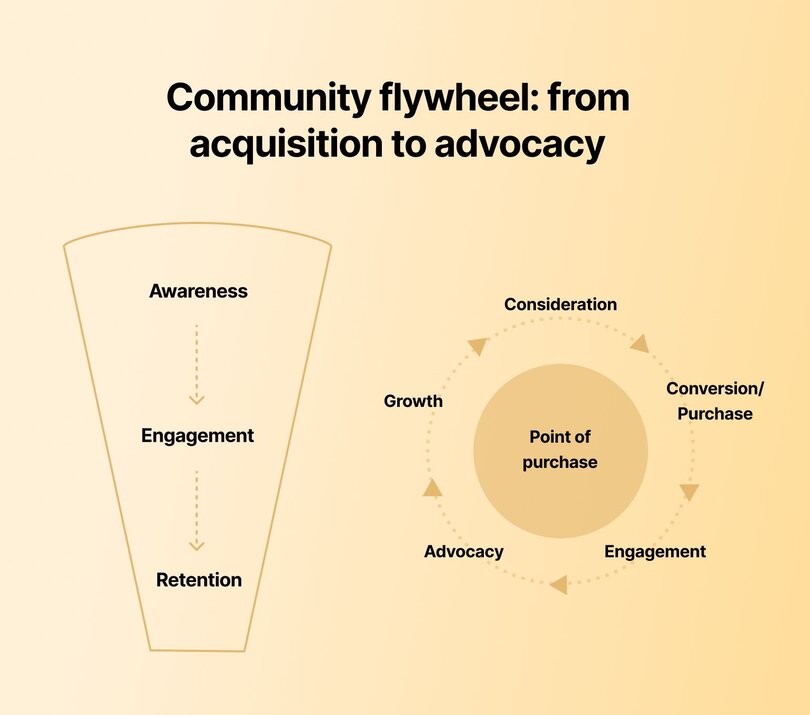
It works like this: You create awareness (people discover your community). They engage (they participate, connect, get value). They become advocates (they naturally share wins and invite others). This drives growth (new members join). Those new members enter at awareness, and the cycle accelerates.
The momentum builds on itself. That's why it's a flywheel, not a funnel—every rotation makes the next one easier.
6 ways to create customer advocates (plus examples!)
Nailing advocacy marketing is a delicate balancing act that shouldn’t be overly engineered. So light the spark, create some guardrails and motivators, and let it grow a life of its own.
1. Build a member-led community
Member-led communities are advocacy incubators. When you create a space where members feel genuinely valued and empowered to contribute, they naturally become your loudest champions.
Take Miro's community on Circle. Their most engaged users (Miro Heroes) run regular show-and-tell sessions, provide product feedback, and create templates for their public-facing template gallery, Miroverse. These members advocate both inside the community and on LinkedIn—earning branded swag, event funding, and product credits while Miro gains authentic marketing reach.
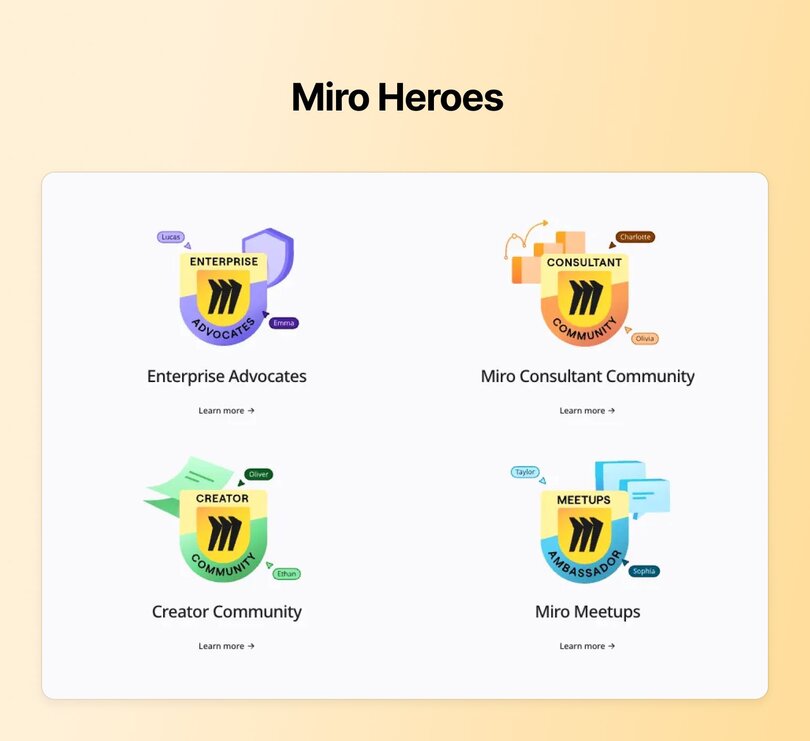
Here's how to build your own member-led advocacy incubator:
- Start with the right foundation—choose a platform that can grow with you and makes member engagement easy (not clunky).
- Focus obsessively on member experience. Quick responses, relevant updates, and hands-on guidance show people you're invested in their success, which makes them want to invest in yours.
- Find your natural leaders—the members who already post actively and help others—and empower them. Give them the spotlight, the resources, and the recognition they deserve.
- Make contributing easy by creating clear frameworks. Whether that's dedicated Q&A channels, a shared resource library, member-hosted events, or social sharing guidelines, people advocate more when they know exactly how to help.
- Start simple. Don't build a complex gamification system on day one. Begin with manual recognition and add sophisticated systems as your community grows.
- Reward what matters. Inside the Show hosts weekly video challenges where winners receive $80 in filming equipment (which they naturally post about). The brand then repurposes these videos as marketing content—advocacy that creates more advocacy.
The result? A community that markets itself because members genuinely want to share their wins and help others succeed.
💡Want to build a truly member-led community? Learn how two top Circle communities—Exit Five and Miro—structured, motivated, and scaled their member-led programs.
2. Highlight member stories (UGC/testimonials)
Member stories are advocacy gold. They show potential customers what's possible and help current members see themselves in others' successes.
At Circle, we practice what we preach. Our 15,000+ member community includes spaces like our welcome area, "ask the community" channel, and share-and-learn forum where members openly discuss their wins, challenges, and breakthroughs.
These authentic conversations become some of our best marketing content. We identify compelling member experiences and transform them into case studies that showcase real results:
- How Talk Nerdy to Me scaled to $37K/month and 300+ active users
- How Glucose Guide increased engagement by 36% using Circle’s custom branded app
- How The eLearning Designer’s Academy rebuilt 75% of his Webflow site in days with no devs
We also maintain a "wall of love" featuring our favorite member testimonials—social proof that feels genuine because it is.
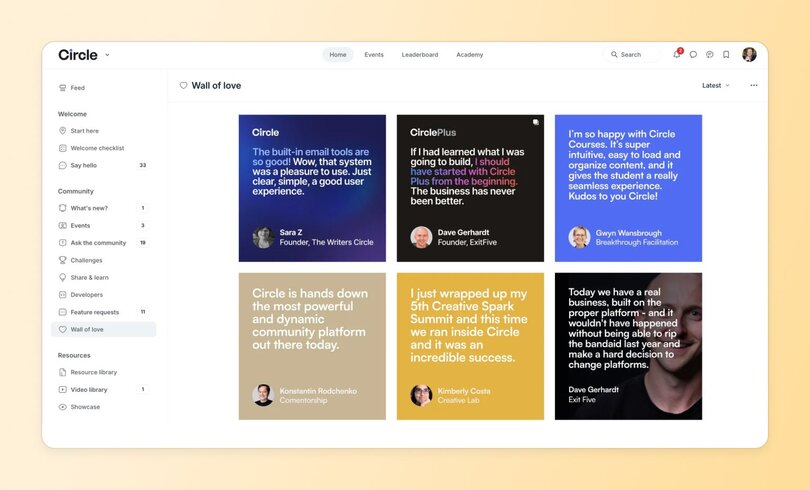
Your playbook for spotlighting member stories:
- Track and reshare social brand mentions—when members tag you or talk about their wins, amplify them.
- Reach out to power users for deeper stories, especially those with engaged audiences who can extend your reach beyond your own channels.
- Turn in-community wins into public testimonials—ask vocal members if you can share their forum posts on social media, email, or landing pages.
- Expand positive reviews into full stories—contact enthusiastic reviewers on platforms like G2, Capterra, or Google and see if they'll collaborate on a detailed case study.
The key? Make it easy for members to say yes by doing the heavy lifting yourself. You handle the writing, editing, and promotion—they just need to share their authentic experience.
3. Gamify referrals and sharing
People who love your brand want to share it—gamification just makes it more fun and rewarding to do so.
Take Whoggga, an exclusive networking community for business owners. Members earn points and unlock new access levels by actively engaging in the community. At level 6 (the Mentor stage), they unlock the ability to invite friends, who get a month of free access plus dedicated mentors. Suddenly, referring isn't just allowed, it's earned status.
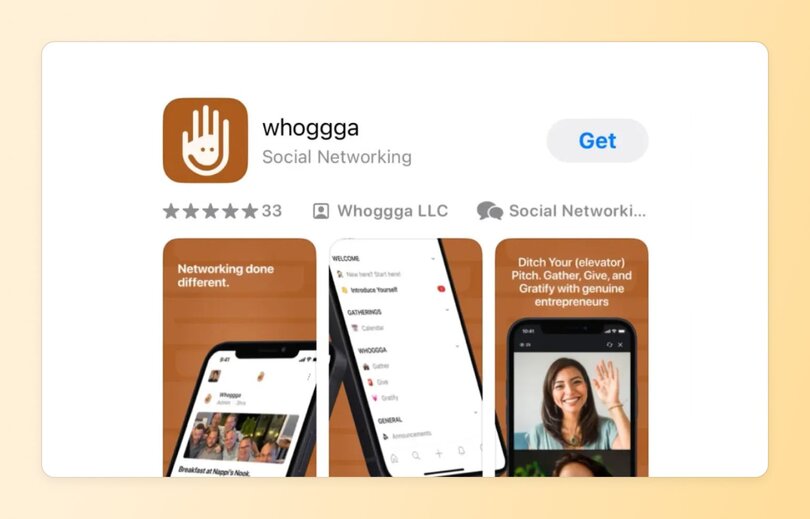
How to gamify advocacy effectively:
- Make referrals a privilege, not a default. Require members to complete their profile, hit the leaderboard, or stay active for a month before they can invite others. When sharing feels exclusive, people actually want to do it.
- Reward both sides. Whether it's credits, exclusive access, swag, or insider perks, make sure both the referrer and their friend get something valuable.
- Remove all friction. Provide invite codes, pre-written messages, shareable graphics, QR codes—whatever makes sharing effortless and enjoyable.
When advocacy feels like a game worth playing, your biggest fans become your most effective marketing team.
4. Host live events to amplify advocates
Your best advocates don't just want to attend events—they want to lead them. And that's perfect, because member-led events are more authentic, cost-effective, and scalable than anything you could produce internally.
Exit Five nails this approach. Community members run virtually all their events while admins simply curate and facilitate. The team rarely even answers forum questions—members jump in to help each other instead.
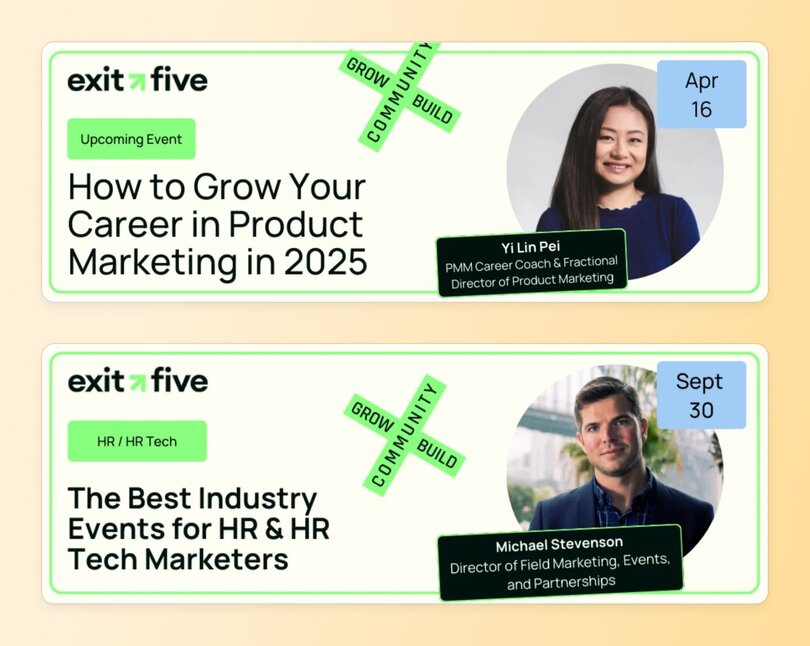
Other ways to turn events into advocacy engines:
- Let active members moderate sessions with guest speakers rather than being the main attraction themselves.
- Host low-pressure co-working or flow sessions where members can connect without the pressure of teaching or presenting.
- Try social media takeovers on Twitter, Instagram Stories, or TikTok, where advocates showcase their perspective.
- Empower real-time advocacy by having vocal members moderate chats or share discussion highlights on social as events unfold.
When members lead events, they naturally promote them to their networks—turning every session into an advocacy opportunity.
5. Empower micro-influencers inside your community
Micro-influencers are already trusted voices in your community—members who are vocal in discussions, influential online, or both. When you spotlight them, you amplify advocacy while strengthening community bonds.
At Circle, we highlight top contributors who regularly share community-building insights. They get more visibility, we get valuable content, and the entire community benefits from their expertise.
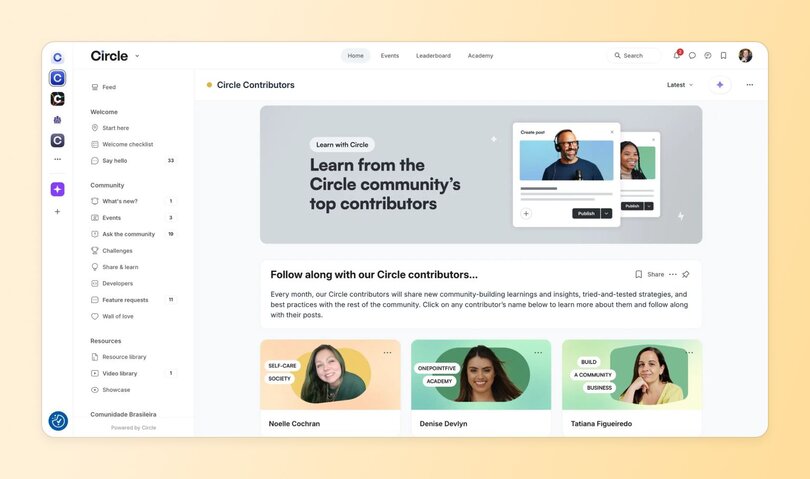
How to empower your community micro-influencers:
- Feature their insights through newsletter takeovers or dedicated spotlight sections.
- Amplify their voices by creating member shoutout posts on your social channels that celebrate their expertise and contributions.
- Help them build sub-communities by encouraging long-term advocates to facilitate smaller peer groups that feel more intimate than public channels.
The more you elevate your internal influencers, the more they'll elevate your brand.
6. Create VIP spaces for top advocates
VIP status isn't just a nice perk—it's a powerful motivator that turns good advocates into exceptional ones.
Whoggga rewards top members with 1:1 founder access, private event invitations, resources for self-hosted gatherings, and store credits. The result? Higher engagement, stronger business habits, and a culture that's genuinely member-led.
To build VIP programs people actually want:
- Make the incentives compelling. Personalized support, exclusive access, branded merch, event sponsorships—whatever genuinely delights your top members.
- Show the path clearly. Embed progress trackers in profiles or create roadmaps in your welcome section so members know exactly how to level up. (Or, just use Circle’s leaderboard and gamification features.)
- Create healthy FOMO. Spotlight existing VIP members and their benefits through leaderboards, social content, and community posts.
When advocacy earns access to something truly special, members will work to get there—and talk about it the entire way.
How to measure advocacy marketing success
Here's the thing about advocacy: when it feels authentic and valuable to your members, the business results follow naturally. But you still need to track what's working so you can do more of it.
These metrics reveal whether your advocacy engine is actually running—or just idling. They also show how well your community is turning engagement into growth:
- Referrals: What percentage of new customers came through referral codes or links?
- UGC volume: How much organic content (social posts, in-community discussions, reviews) are members creating?
- Retention: How many customers stick around after their first interaction?
- Community-led signups: How many new customers were referred by community members or started as community members first?
Turn your community into your marketing engine
Brand advocates aren't a side effect of good business—they're a strategic growth channel that compounds over time. Build a community where members can share knowledge, connect authentically, and grow together, and you'll stay top-of-mind in the best possible way.
Ready to build your advocacy engine? Start your Circle community today (free for 14 days) and turn your happiest customers into your most effective marketing team.
FAQs about advocacy marketing in communities
What are examples of advocacy marketing?
One inspiring advocacy marketing example is Pat Flynn’s Smart Passive Income (SPI) community. Pat went from being laid off to building a leading entrepreneurship education brand with over $1 million in yearly revenue, largely powered by organic growth and referrals. Some mainstream examples of advocacy marketing include Apple’s #ShotonanIphone campaign and Coca-Cola’s “Share a Coke” strategy.
How do solopreneurs turn customers into advocates?
Solopreneurs turn customers into advocates by building a member-led community, highlighting user stories, gamifying referrals and sharing, and hosting live events to amplify their top contributors. Empowering micro-influencers within their communities and creating VIP spaces for them to thrive also helps.
What are the types of advocacy in marketing?
The types of advocacy in marketing include customer advocacy, employee advocacy, and partner advocacy.
- Customer advocacy is when a satisfied and loyal brand user happily endorses it.
- Employee advocacy is when an engaged staff member actively promotes their employer’s brand.
- Partner advocacy is when other brands, typically with aligned values and goals, help amplify yours (via cross-promotion, event collabs, or collaborative posting).
How do you maintain engagement as your community grows?
As your community grows, move from high-touch, one-to-one tactics to systems that scale.
Automate onboarding, set up recurring rituals, and invite members to take on leadership roles. You can also mix in structured events, tiered spaces, or gamification to keep things engaging without stretching yourself thin.